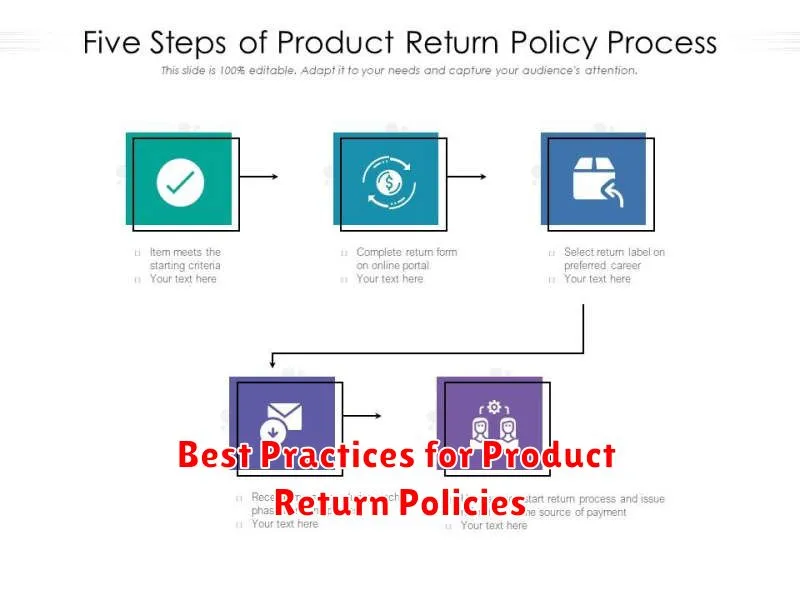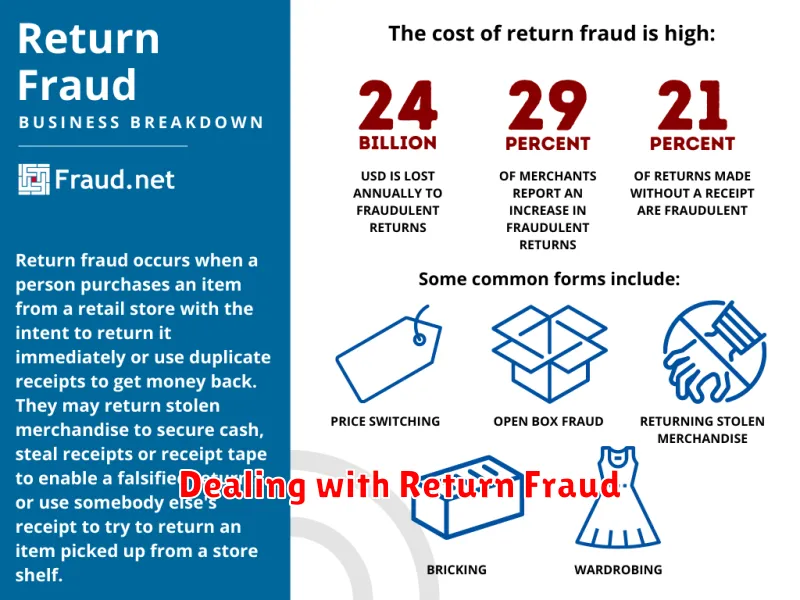In today’s competitive e-commerce landscape, a customer-friendly product return policy is no longer a luxury, but a necessity. It’s a critical element that can significantly impact your online store’s success, influencing customer satisfaction, brand loyalty, and ultimately, your bottom line. A well-crafted return policy fosters trust with potential buyers, reduces purchase anxiety, and encourages higher conversion rates. This article will guide you through the process of creating a customer-centric return policy that benefits both your customers and your business, covering key aspects such as eligibility criteria, return process, timeframe, and cost.
Crafting the perfect return policy requires balancing customer expectations with your business needs. A policy that’s too lenient could lead to losses from fraudulent returns and increased operational costs, while a policy that’s too restrictive could deter potential customers and damage your brand reputation. This guide provides a practical framework for developing a comprehensive return policy that addresses common customer concerns, minimizes return fraud, and streamlines the return process for maximum efficiency. Learn how to turn returns from a potential headache into a positive customer experience that builds loyalty and drives repeat business.
Why a Clear Return Policy is Essential
A well-defined return policy is crucial for building trust and fostering customer loyalty in online retail. It directly impacts a customer’s purchasing decision, as it reduces the perceived risk associated with buying online. When customers feel confident they can return an item if it doesn’t meet their expectations, they are more likely to complete a purchase.
Clarity in your return policy minimizes misunderstandings and disputes. A vague or confusing policy can lead to frustration for both the customer and your business. Clearly outlining the terms and conditions, such as the return window, eligible items, and refund process, prevents ambiguity and sets clear expectations from the outset.
A customer-friendly return policy can also be a competitive advantage. It demonstrates your commitment to customer satisfaction and can encourage shoppers to choose your store over a competitor with less flexible return options. By offering a hassle-free return experience, you build a positive brand reputation and encourage repeat business.
Key Elements of a Good Return Policy
A well-crafted return policy hinges on several key elements that contribute to both customer satisfaction and efficient business operations. Clarity is paramount. The policy should be easily understood, avoiding complex jargon or confusing terms.
Timeframe is another crucial factor. Specify a reasonable return window, such as 30, 60, or 90 days. Condition of Goods should be clearly defined. Outline acceptable return conditions, for instance, unworn, unused, with original tags and packaging.
Address the Process for Returns, outlining the steps customers need to take. This may involve obtaining a Return Merchandise Authorization (RMA) number or printing a prepaid shipping label. Specify Refund Options, such as original payment method, store credit, or exchange.
Finally, clearly state any Non-Returnable Items. This might include personalized items, perishable goods, or items marked as final sale.
Understanding Different Return Policy Options
When crafting your return policy, consider various options to find the best fit for your business and customers. Full refunds are the most customer-friendly, offering a complete monetary reimbursement upon return. This builds trust but can be costly.
Store credit offers a refund as a credit applicable to future purchases. This encourages repeat business but might not satisfy all customers. Exchanges allow customers to swap the returned item for a different size, color, or even a completely different product.
A restocking fee, typically a percentage of the purchase price, can help offset processing costs associated with returns. However, be transparent about this fee upfront. Finally, you can set a return window, specifying the timeframe within which returns are accepted (e.g., 30, 60, or 90 days).
How to Write a Return Policy
A well-written return policy is clear, concise, and easy to understand. Start by stating your overall policy timeframe (e.g., 30, 60, or 90 days). Clearly define the conditions for returns, such as whether items must be unworn, unused, and in their original packaging. Specify who pays for return shipping – the customer or your business.
Address how refunds are issued, whether as store credit, a refund to the original payment method, or an exchange. If you offer different return options for different product categories, be sure to explicitly state these variations. Use simple language and avoid legal jargon to ensure clarity for all customers.
Consider including examples to illustrate different return scenarios. A well-organized format with clear headings and bullet points can make your policy easy to navigate. Finally, review your policy regularly and update it as needed to reflect any changes in your business operations or legal requirements.
Communicating Your Return Policy to Customers
Clearly communicating your return policy is just as important as having a good one. A well-communicated policy builds trust and reduces customer frustration. Make sure your policy is easily accessible to customers throughout their shopping journey.
Placement is key. Feature your return policy prominently on your website. Include it in your website footer, FAQ section, and product pages. Consider a dedicated “Shipping and Returns” page for in-depth information.
During the checkout process, provide a clear summary of your return policy. Customers should acknowledge the policy before finalizing their purchase. This helps avoid surprises later.
Reinforce your policy in post-purchase communications. Include it in shipping confirmation emails and order packing slips.
Clarity is paramount. Use simple language and avoid jargon. Consider offering a multi-lingual version of your policy if you serve international customers. Using bullet points or numbered lists can improve readability.
Offer multiple contact channels for customers with return questions. Provide clear instructions on how to initiate a return, including required documentation and shipping procedures.
Handling Returns Efficiently
Efficient return handling is crucial for both customer satisfaction and operational efficiency. A streamlined process minimizes costs and frustration for everyone involved.
Provide clear return instructions: Include a detailed return policy document with each order and make it readily available on your website. This should outline the steps a customer needs to take, including how to initiate a return, packaging requirements, and shipping options.
Offer multiple return options: Consider offering options like pre-paid shipping labels, drop-off locations, or in-store returns (if applicable). This gives customers flexibility and convenience.
Automate the process: Utilize a returns management system to automate tasks such as generating return labels, tracking returned items, and processing refunds. This reduces manual work and speeds up the process.
Train your staff: Ensure your customer service team is well-trained in handling return requests efficiently and empathetically. They should be able to answer questions, resolve issues, and process returns quickly.
Best Practices for Product Return Policies

A well-crafted return policy builds trust and encourages purchases. Clarity is paramount. Use plain language, avoiding jargon. Clearly state the return window, for example, “30 days from the date of delivery.”
Outline the conditions for returns. Specify whether items must be in their original packaging, unused, and with tags attached. Detail the accepted return methods, such as mail or in-store drop-off. Provide prepaid return shipping labels whenever feasible to enhance customer convenience.
Offer multiple refund options. Customers may prefer a refund to their original payment method, store credit, or an exchange. Clearly explain the process for each option.
Make your return policy easily accessible. Feature it prominently on your website, within order confirmations, and on packing slips. A dedicated FAQ page addressing common return questions can also be beneficial.
Reducing Return Rates While Maintaining Customer Satisfaction
Minimizing returns is crucial for profitability, but it shouldn’t come at the expense of customer satisfaction. A balance must be struck to ensure a positive shopping experience while reducing unnecessary returns.
Detailed product descriptions and high-quality images are paramount. Customers should have a clear understanding of the product’s features, dimensions, and materials. Size charts and fit guides, where applicable, can significantly reduce returns due to sizing issues.
Customer reviews and Q&A sections can also play a significant role. Allowing customers to share their experiences and ask questions can address potential concerns before purchase. This transparency fosters trust and helps customers make informed decisions.
Offering excellent customer service is key. Addressing pre-purchase inquiries promptly and thoroughly can eliminate doubts and prevent returns. Providing multiple contact channels for support further enhances the customer experience.
Dealing with Return Fraud

Return fraud is a serious concern for online businesses. Identifying and preventing fraudulent returns is crucial for maintaining profitability and operational efficiency. A clear and concise return policy can act as the first line of defense.
Common types of return fraud include wardrobing (wearing an item and returning it), returning stolen merchandise, and returning counterfeit items as authentic.
Strategies to mitigate return fraud include:
- Requiring receipts or proof of purchase: This helps deter individuals returning stolen goods or items purchased elsewhere.
- Implementing a restocking fee: This can discourage frivolous returns and help offset the cost of processing returns.
- Setting time limits for returns: A reasonable return window (e.g., 30 days) can help prevent wardrobing and reduce the likelihood of receiving damaged or used merchandise.
- Tracking serial numbers: For high-value items, tracking serial numbers can help identify fraudulent returns.
- Flagging suspicious activity: Monitor returns for patterns indicative of fraud, such as frequent returns from the same customer or returns of items consistently out of stock.
Maintaining a balance between fraud prevention and customer satisfaction is essential. While stringent policies can deter fraud, overly strict measures can alienate legitimate customers.
Examples of Effective Return Policies
Examining successful return policies from other businesses can provide valuable insights for crafting your own. Here are a few examples showcasing different approaches:
Example 1: The “No Questions Asked” Policy
This policy prioritizes customer satisfaction above all else. Returns are accepted within a reasonable timeframe (e.g., 30-60 days) regardless of the reason. This builds trust and encourages purchases, but can be susceptible to abuse.
Example 2: The “Free Return Shipping” Policy
Offering free return shipping removes a major barrier for customers. This approach can increase conversions and reduce cart abandonment, but the added cost needs to be factored into pricing. It’s often effective for businesses with higher profit margins.
Example 3: The “Tiered” Return Policy
This policy offers different return options based on product type or condition. For instance, unopened items might have a longer return window and free shipping, while opened items may incur a restocking fee or require the customer to pay for return shipping. This balances customer satisfaction with business needs.

